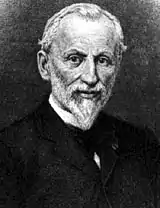Jean-Baptiste Édouard Bornet
Jean-Baptiste Édouard Bornet (September 2, 1828, Guérigny – December 18, 1911, Paris) was a French botanist. The standard author abbreviation Bornet is used to indicate this person as the author when citing a botanical name.[1]

Life
Bornet studied medicine in Paris, and in 1886 became a member of the French Académie des sciences. With Gustave Thuret, he was co-author of Notes algologiques (1876-1880) and the Études phycologiques (1878), both works being published after Thuret's death in 1875.[2] He helped establish the nature of lichens and was the first to find the reproductive process of red algae.[3] In the field of lichenology, he wrote Recherches sur les gonidies des lichens (1873). With Charles Flahault, he published on Nostocaceae: Revision des Nostocacées héterocystées (1886–88).
Awards and honours
In 1877, botanist Munier-Chalmas published Bornetella is a genus of green algae in the family Dasycladaceae and named in Jean-Baptiste Édouard Bornet's honor.[4]
Bornet was elected a member of the Royal Swedish Academy of Sciences in 1888.
He was awarded the Linnean Medal in 1891.
He was admitted as a Foreign Member to the United Kingdom's Royal Society in 1910.[5]
See also
- Category:Taxa named by Jean-Baptiste Édouard Bornet
References
- International Plant Names Index. Bornet.
- Proceedings of the American Academy of Arts and Sciences
- Chisholm, Hugh, ed. (1922). . Encyclopædia Britannica (12th ed.). London & New York: The Encyclopædia Britannica Company.
- Guiry, Michael D. (2021). "Bornetella Munier-Chalmas, 1877". WoRMS. World Register of Marine Species. Retrieved 18 November 2021.
- "Library and Archive Catalogue". Royal Society. Retrieved 17 December 2010.